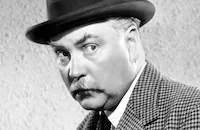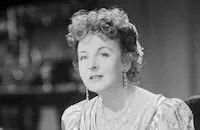Journey for Margaret

Brief Synopsis
Cast & Crew
Major W. S. Van Dyke Ii
Robert Young
Laraine Day
Fay Bainter
Nigel Bruce
Margaret O'brien
Film Details
Technical Specs

Synopsis
After the fall of France during World War II, world weary newspaper correspondent John Davis and his pregnant wife Nora travel to London where they are met by John's colleague, Herbert V. Allison. Although John pleads with Nora to return home to the safety of Connecticut, she refuses to leave his side. As more European countries fall to the Germans, Nora fears that John has become jaded and is loosing his conviction. One night while on a foray into the blitzkrieged streets of London, John encounters a little boy clutching a stuffed lamb buried in the rubble left behind by the German bombers. Upon returning to his hotel, John discovers that Nora has been injured in the air raid and taken to the hospital. At the hospital, the doctor informs John that Nora has lost their baby and will never be able to have another. Although the doctor has advised John to withhold the bad news from Nora, she senses the truth and is driven to hysterics. While trying to calm Nora, John finds the little boy's lamb stuffed in his coat pocket. Months later, Nora has recovered her health but not her equilibrium. She is about to fly home when Allison asks her to stay with John and face what has happened to her, but denying the extent of her pain, Nora disregards his advice and returns home. Assigned by Allison to write a story about an orphanage for war refugees, John proceeds to the Riswick Children's Home and meets its director, Trudy Strauss. There, John is moved by the traumatized children, the innocent victims of war, and recognizes the little boy he pulled from the ruins. Trudy explains that the boy, Peter, has not spoken since coming to the orphanage. When John returns the stuffed lamb to the boy, Peter develops a profound attachment to him and John promises to join him later for tea. Afterward, one of the foster parents returns to the orphanage a troubled little girl named Margaret. From Margaret's neck dangles a chain holding the casing from a bomb. When Margaret refuses to part with the bomb and continually wipes her dry eyes, Trudy coaxes her to shed her tears of mourning for her dead mother. At tea, Peter begins to come out of his depression and relate to the other children. Later, John helps bathe the children and Margaret and Peter both vie for his attention. After the children are put to bed, the rumbling bombers strike and John comforts the panicked Margaret. That night, the city is enveloped in flames following a bombing raid. As John and Allison prowl the streets in search of a story, John comes upon a woman carrying the lifeless body of her child. His anger aroused by the atrocities of war, John becomes revitalized and goes to see Margaret and Peter. There, Trudy tells John that the children are being sent to meet their prospective foster parents, the Barries, and asks John to take them to the Barrie house. Upon arriving at the house, the children cling to John. Although the kindly couple showers them with gifts, Peter and Margaret are morose and after Margaret begs John not to leave her, he takes them back to the orphanage. Deeply perturbed by the children's distress, John cables Nora that he is coming home and asks her permission to adopt the children. He receives a reply from Nora's mother, notifying him that Nora is ill but will undoubtedly want the children. Soon after, John receives a cable from Nora, relating that the notion of a real home with children shocked her back into reality and that she now will welcome the children into their family. When John tries to arrange passage for the children back to the U.S. however, he discovers that the plane for the first leg of the journey, from London to Portugal, is completely full. When he proposes asking one of the passengers to relinquish their baggage allowance so that both children can travel on the flight, Susan Fleming of the British Ministry of Information provides him with a list of the passengers. When all eight travelers either cannot or will not respond to his pleas, John is forced to leave behind one of the children and Trudy insists that an intelligence test should determine which lucky child will accompany him. After Margaret scores highest on the test, Peter, dejected, retreats into his shell. As John and Margaret board the train for the airport, Margaret, who at first is angry at John, breaks down in tears at the idea of leaving Peter behind and calls John "Daddy." At the airport, John and Margaret are walking toward the terminal when a car carrying Mrs. Bailey, one of the passengers, appears and Peter climbs out. The elderly Mrs. Bailey then explains that she has foresaken her baggage so that Peter can fly to Portugal and there board the ship bound for America and a new life. As their ship approaches New York, the children are thrilled by the glistening lights of the city. Nora tearfully greets her new family aboard the boat, and when the air raid sirens wail and the lights slowly blink out, Nora assures the children that they will go on once the war is over, never to be extinguished again.

Cast

Robert Young

Laraine Day

Fay Bainter

Nigel Bruce

Margaret O'brien
William Severn

Elisabeth Risdon

Doris Lloyd

Halliwell Hobbes
Heather Thatcher
Jill Esmond
G. P. Huntley Jr.
Lisa Golm

Charles Irwin
Clare Sandars
Vickie Campbell
Leyland Hodgson
Matthew Boulton
Lilyan Irene
Ottola Nesmith
Leslie Francis
Olaf Hytten
John Burton
Colin Kenny
Joan Kemp
Norbert Muller
Al Ferguson
George Aldwin
Bea Nigro
Cyril Delevanti
Jody Gilbert
Crauford Kent

Keye Luke
William H. O'brien
Jimmy Aubrey
Norman Ainsley
Eric Snowden
Doris Stone
Robert Cory
David Thursby
Clive Morgan
Henry Guttman
John Power
Gil Perkins
Henry Glynn
Major Douglas Francis
Jack Deery
Alan Schute
Elizabeth Williams
Stephanie Insall
Doreen Munroe
Lotus Thompson
Jean Ransom
Sybil Bacon
Frank Baker
Art Berry Sr.
Herbert Clifton
Eric Wilton
Henry King
Gay Bennes
Hal Welling
Herbert Evans
Anita Bolster
Cyril Thornton
Emerson Fisher-smith
Lawrence Grossmith
Crew
Hugh Boswell
B. P. Fineman
Cedric Gibbons
David Hertz
Ray June
Kalloch
William Ludwig
Dick Pefferle
Wade B. Rubottom
Dore Schary
Douglas Shearer
Paul Vogel
Franz Waxman
George White
Edwin B. Willis

Videos
Movie Clip



Trailer
Hosted Intro



Film Details
Technical Specs

Articles
Journey for Margaret
Journey for Margaret was based on a true story, told in the 1941 book of the same name by American journalist William L. White. Called "one of the most moving books to come out of the war" by Life Magazine, Journey for Margaret was White's own very personal story of war and family.
Journey for Margaret was the first major film role for 5-year-old actress Margaret O'Brien. MGM executives had noticed Margaret (who was still going by her real name Maxine at the time) in a bit part in the 1941 Mickey Rooney/Judy Garland vehicle Babes on Broadway. Impressed with her brief but memorable performance, MGM decided to star O'Brien in Journey for Margaret, changing her first name in the process to that of the title character.
O'Brien's heartbreaking performance helped make Journey for Margaret a hit at the box office, and the pint-sized actress became an instant star. An extraordinarily gifted actress, O'Brien stood out among other child stars. There was no sugary cuteness to her performances. She had a dramatic range well beyond her years and was capable of handling serious complex roles in which she could hold her own against some of Hollywood's biggest movie stars. The New York Times called Journey for Margaret "one of the year's rare and shining achievements from Hollywood...a picture of tortured childhood that will not soon be forgotten by anyone who has ever loved a child...Of little Margaret O'Brien...one can hardly say that she gives a performance - it is too taut and true for that." Time Magazine said, "An unpretentious tale of the quiet side of war, the picture is remarkable for its understanding of children and its exquisite performances...best of all is five-year-old [Margaret] O'Brien...she seems already to have learned as much about life as the real Margaret must have learned."
Following her success in Journey for Margaret, Margaret O'Brien was quickly signed to a long-term contract with MGM where she became one of the most popular stars of the 1940s. Journey for Margaret helped establish her as one of the most remarkable child actresses of all time with a truly moving performance that gives a unique child's perspective on the horrors of war.
Producers: B.P. Fineman, Dore Schary
Director: Maj. W.S. Van Dyke II
Screenplay: David Hertz, William Ludwig; William L. White (book)
Cinematography: Ray June
Art Direction: Cedric Gibbons, Wade B. Rubottom
Music: Franz Waxman; Mario Castelnuovo-Tedesco, Sol Kaplan, Eric Zeisl (all three uncredited)
Film Editing: George White
Cast: Robert Young (John Davis), Laraine Day (Nora Davis), Fay Bainter (Trudy Strauss), Nigel Bruce (Herbert V. Allison), Margaret O'Brien (Margaret White), William Severn (Peter Humphreys), Elisabeth Risdon (Mrs. Bailey), Doris Lloyd (Mrs. Barrie), Halliwell Hobbes (Mr. Barrie), Heather Thatcher (Mrs. Harris), Jill Esmond (Susan Fleming), G.P. Huntley (Rugged), Lisa Golm (Frau Weber).
BW-81m. Closed Captioning.
by Andrea Passafiume

Journey for Margaret
Quotes
Trivia
Notes
The film opens with the following written prologue: "The Margaret of this story is real. She hopes, with the rest of us, for ever lasting peace after the war is won. This picture is dedicated to her. This is a small dedication. The great dedication is being made by millions of men and women who are fighting on far-flung battlefronts for all the Margarets of the world." According to a November 1941 Hollywood Reporter news item, William L. White's novel was based on an account by the author and his wife of their experiences adopting an orphan in London where White worked as an American correspondent during the London blitz. According to M-G-M production notes contained in the AMPAS Library file on the film, White's factual account of the adoption had been previously published in Reader's Digest and Life.
The opening onscreen credit order varies slightly from that of the closing credits. Margaret O'Brien's opening credit reads "and presenting Margaret O'Brien as Margaret" and appears after William Severn's name. Although Hollywood Reporter production charts list Herbert Kline as director during the first two weeks of production, he was then replaced by W. S. Van Dyke. According to a June 9, 1942 Hollywood Reporter news item, Kline wanted Dorothy Comingore for the role of "Anya." Although CBCS, Hollywood Reporter production charts and news items list Signe Hasso in the role of Anya, neither she nor the character appeared in the released film. Journey for Margaret would have marked the American motion picture debut of the Swedish-born Hasso, but her first appearance was in the 1943 M-G-M film Assignment in Brittany in 1943. A March 1942 Hollywood Reporter news item adds that Carolyn Lee was considered for a lead in the film. An M-G-M news item hat Sam Marx was originally to produce the picture. Although various Hollywood Reporter news items add George Kirby, Mary Alice Moore, Tom Murray, Bud Penny, Arthur Lovejoy and Ginny Wren to the cast, their appearance in the released film has not been confirmed.















